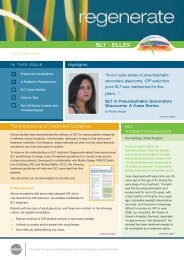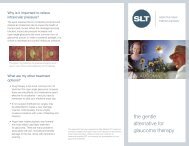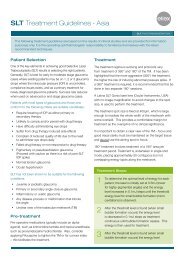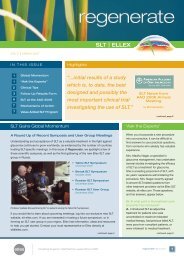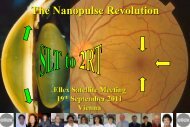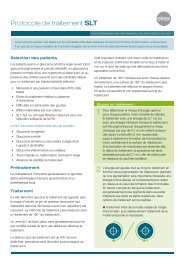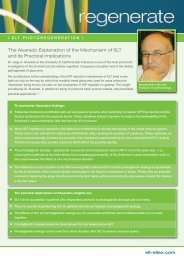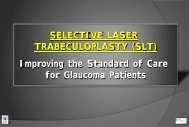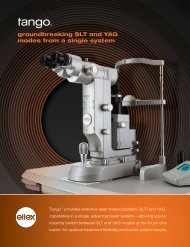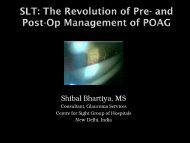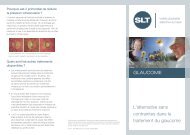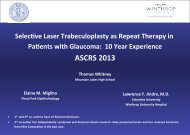Regenerate - SLT for Glaucoma | Ellex
Regenerate - SLT for Glaucoma | Ellex
Regenerate - SLT for Glaucoma | Ellex
- No tags were found...
Create successful ePaper yourself
Turn your PDF publications into a flip-book with our unique Google optimized e-Paper software.
Efficacy of <strong>SLT</strong> in Ocular Hypertension and Primary Open-Angle <strong>Glaucoma</strong>:Primary Treatment Vs. Adjunct TreatmentPrimary Tarek Eid, Treatment MD, Associate vs. Adjunctive Professor of Therapy Ophthalmology, Tanta University, EgyptSelective lasertrabeculoplasty (<strong>SLT</strong>)has been gaining wideracceptance since itsintroduction in 1995 byLatina & Park 1 . Clinicalstudies suggest <strong>SLT</strong> isefficacious in lowering IOP,either as initial treatmentor when used adjunctive tomedical therapy. Responserates after one year rangefrom 59-96 percent, withaverage IOP reductionfrom 18-40 percent 2-4 .Dr. Tarek M. Eid, assistant professor at the Magrabi Eye & EarCenter in Jeddah, Saudi Arabia, has just completed a study todetermine the IOP-lowering effect of <strong>SLT</strong> when used as initialtreatment or as adjunctive therapy <strong>for</strong> primary open-angleglaucoma (POAG) or ocular hypertension (OH). The followingare his findings and observations.Patient selection and laser techniqueFor this study, patients were classified into two groups. The firstgroup included newly diagnosed eyes with POAG or OH, andthe second included patients diagnosed with POAG or OH andcurrently on medical treatment with or without previous ALTtreatment.All patients received one drop of brimonidine immediatelybe<strong>for</strong>e the laser treatment to prevent post-operative pressurespikes. All eyes had surface anesthesia immediately be<strong>for</strong>e theprocedure.The patient was com<strong>for</strong>tably seated on the slit lamp chair anda Goldmann 3-mirror lens was inserted in the eye coupled withviscoelastic. The gonioscopic mirror of the lens was rotated toview the inferior angle. The aiming beam was focused on thetrabecular meshwork (TM) and a single 400µm spot with 0.8mJpower was delivered at the 12 o’clock position. The power wasincreased or decreased by 0.1mJ according to the absence orpresence of cavitation bubbles.The end point is maximum energy beyond which a bubbleappears in the TM.The procedure was then continued at this energy level withadjacent but non-overlapping laser spots. Throughout theprocedure, bubble <strong>for</strong>mation was monitored with each pulseand energy level was adjusted as described be<strong>for</strong>e. Thetreatment plan was variable, with most of the eyes receiving270-degree or 360-degree treatment, with the average numberof shots ranging between 75 and 100.All eyes received non-steroidal anti-inflammatory drops everysix hours <strong>for</strong> five days. Patients were examined after one day,one week, one month, three months, and periodically everythree months. Withdrawal or addition of anti-glaucoma dropsor repetition of laser treatment in either group was per<strong>for</strong>medaccording to the IOP level throughout the follow-up period.ResultsThe study included 27 eyes of 15 patients in the primarytreatment group (Group 1) and 45 eyes of 28 patients in theadjunctive treatment group (Group 2). Sixteen eyes (59.3percent) in Group 1 and 39 eyes (86.7 percent) in Group 2 haddiagnosis of POAG. Most of the eyes in Group 2 (77.7 percent)were using one or two anti-glaucoma medications.Laser treatment was confined to three or four quadrants ofangle circumference. Baseline IOP was significantly higher inGroup 1 (24.8 + 3.5 mmHg) than Group 2 (18.4 + 3.6 mmHg)(p



